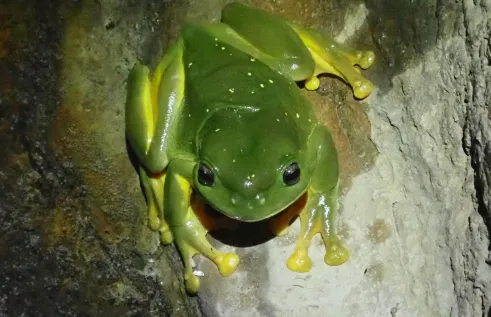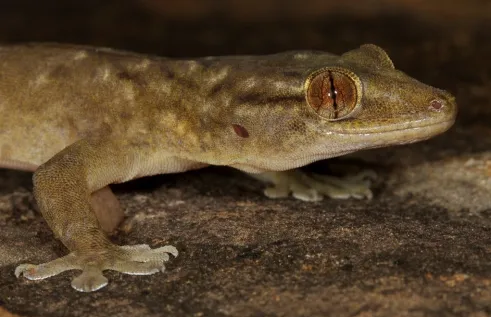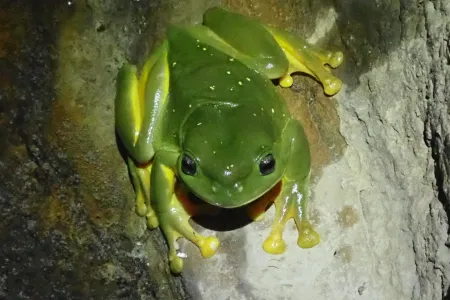Our focus
Many animals have evolved unique adaptations to survive the extreme variations of the wet-dry tropics.
These include seasonal shifts in thermoregulatory behaviour, seasonal changes in metabolic physiology, and a range of adaptations to manipulate water balance to survive prolonged dry conditions, and, conversely, mechanisms to avoid taking up too much water in the wet season.
Specialist expertise
We combine field and laboratory experiments with microclimate measurements and mechanistic modelling to identify the importance and plasticity of animal physiological traits in relation to microhabitat use, seasonal activity patterns, and geographic distribution.
Meet the team
- Prof Keith Christian
- Kimberley Day
- Dr Carla Eisemberg
- Dr Chava Weitzman
- Kade Skelton
- Dr Christine Schlesinger
- Prof Karen Gibb
- Dr Mirjam Kaestli
- Adrian Gurra
- Angga Rachmansah
Why this research is important
Questions about how animals survive in particular microhabitats have long been a central focus of classical ecology, but these topics have become increasingly important with respect to climate change. In order to develop adequate conservation responses to climate change challenges, it is crucial that we understand the interface between animals and their environment.
Key achievements and impacts
- Discovery of unique adaptations, including underwater nesting by a freshwater turtle, seasonal metabolic depression by some reptiles and amphibians, paracellular absorption by juvenile crocodiles, and phylogenetic patterns in cutaneous resistance among frogs.
- Quantifying amphibian and reptile skin-associated microbiomes across species, space, and microhabitats.
- Discovery that microbial communities on reptile skin are as diverse and species-specific as those found on the more widely studies skins of amphibians.
- Determining that disease exposure may drive selection of anti-fungal bacteria on the skin of invasive Australian cane toads.
- Documenting that dehydration enhances innate immunity in a semi-aquatic snake.
Key projects
Are evolutionary refugia traps for endemic species?
This is an ARC Discovery project (2019-2021) in collaboration with Professor Craig Moritz of the Australian National University which aims to determine whether species that have small geographic ranges and which live in historically stable refugia have evolved narrow climatic tolerances.
The project will compare such species with more widespread, related species living in the same areas and combine field- and lab-based estimates of physiological tolerances with genomic estimates of population history and diversity.
The expected outcome is to test the prediction from evolutionary theory that small-range, refugial species are intrinsically more sensitivity to climatic change. This addresses a fundament question in evolution and ecology and should provide improved guidance for ecological management of biodiversity hotspots.
Skin Microbes and Animal Health: Learning to Walk Before We Run
This project aims to better understand the fundamental ecological and biogeographical relationships between animal hosts (frogs and geckos), and bacteria on their skin.
Skin microbial communities provide protection against disease, but little is known about how they function.
Significantly, the project aims to understand both the microbes and the chemicals they produce.
Expected outcomes include foundational information that will guide future research efforts related to the factors that determine a healthy skin microbial community, which is needed before skin diseases can be combated.
The benefit of this research is that it will provide information needed to inform and target conservation efforts to combat wildlife skin diseases.
Orange-footed Scrubfowl Nesting Mound Ecology
The overall aim is to add to our understanding of the breeding and mound ecology of the Orange-footed Scrubfowl.
This project will add to existing knowledge on this topic by employing two modern techniques that were not available in the recent past, thereby modernising and improving or knowledge of this unusual form of nesting by birds.
The new techniques are:
- the use of wildlife camera “traps” to quantify the annual activity of the birds on and around the nesting mounds
- the use of Next Generation Sequencing (NGS) to identify the microbes associated with the generation of heat used for egg incubation in the Scrubfowl mounds.
Interested in Animal Physiological Ecology?
Publications snapshot
-

Skin microbiota of tropical frogs
The frog skin microbial community represents a complex mix of microbes that are promoted by the chemical environment of the frog skin and influenced by the animal's immediate past environment. The microbial communities of six species of frogs sampled from the campus of Charles Darwin University (CDU) were more similar within species than between species.
Read more -

Anti-fungal bacteria on cane toads
Cane toads, an invasive species in Australia, are resistant to fungal pathogens affecting frogs worldwide (Batrachochytrium dendrobatidis). From toad skin swabs, we detected higher proportions of bacteria with antifungal properties in Queensland, where toad and pathogen distributions overlap, than in other sites.
This finding suggests that site-specific pathogen pressures help shape skin microbial communities. Weitzman, C.L., M. Kaestli, K. G.P. Brown, R. Shine, K. Christian. 2019. Disease exposure may drive selection of anti-fungal bacteria on the skin of invasive Australian cane toads. Emerging Infectious Diseases 25:1770-1771 doi:10.3201/eid2509.190386.
Read more -

Skin bacterial diversity in tropical lizards and frogs
Amphibian skin bacteria form distinct communities closely tied to their host species, but few studies have compared bacterial communities between amphibians and other, non-amphibian sympatric animals.
We found bacterial communities had higher richness and diversity on lizards than frogs, with different community composition between reptiles and amphibians and among species.
Read more
